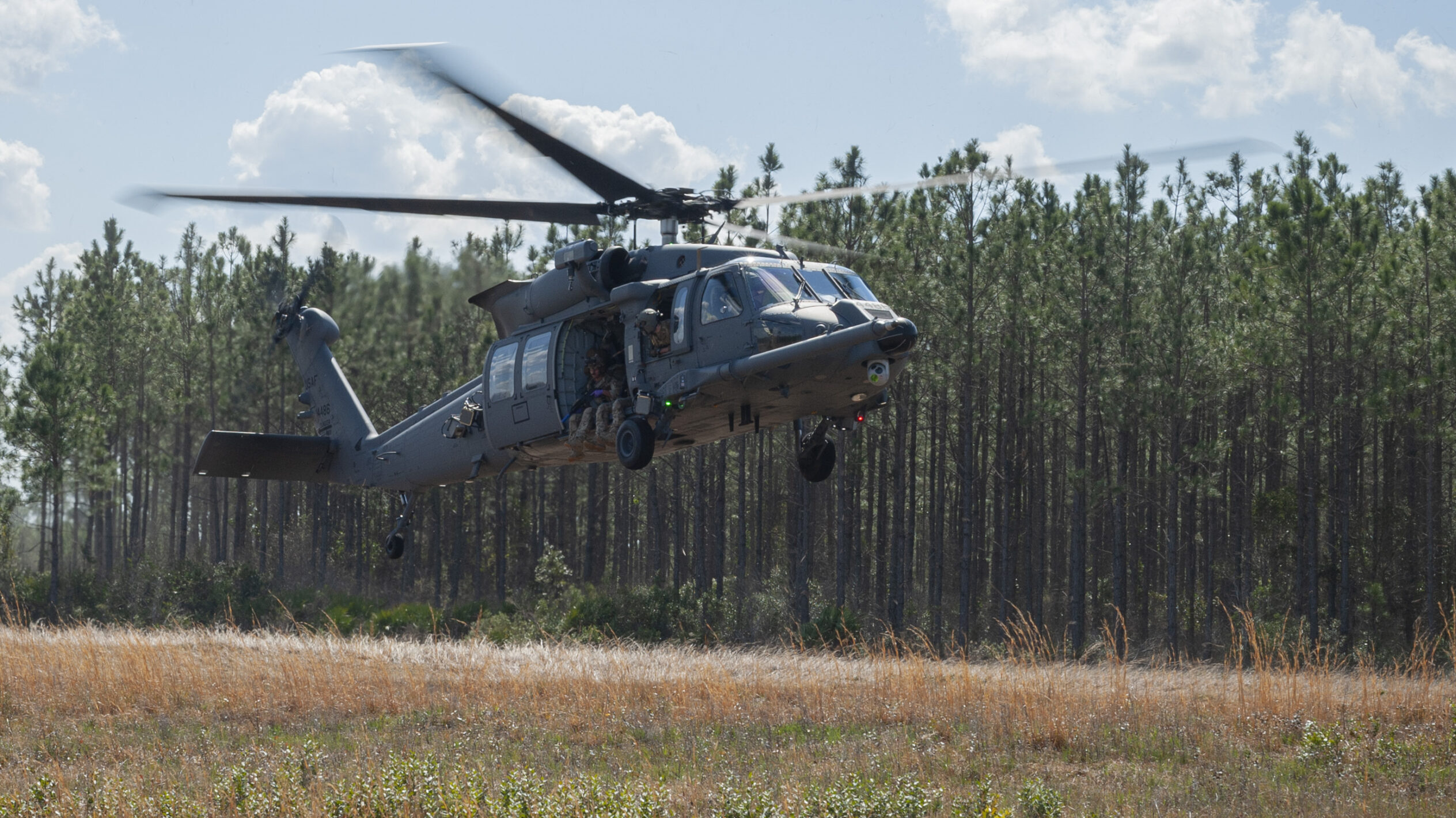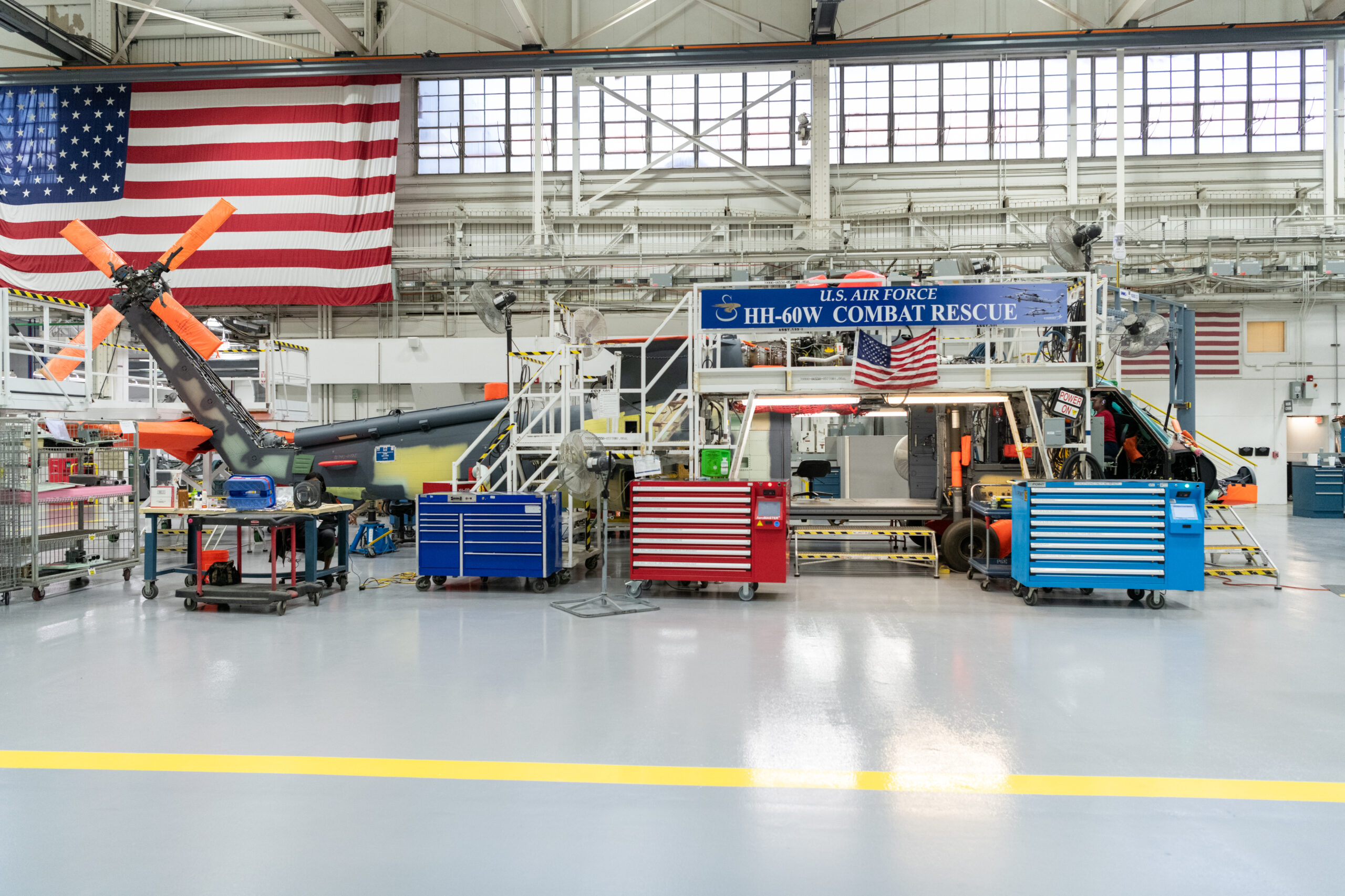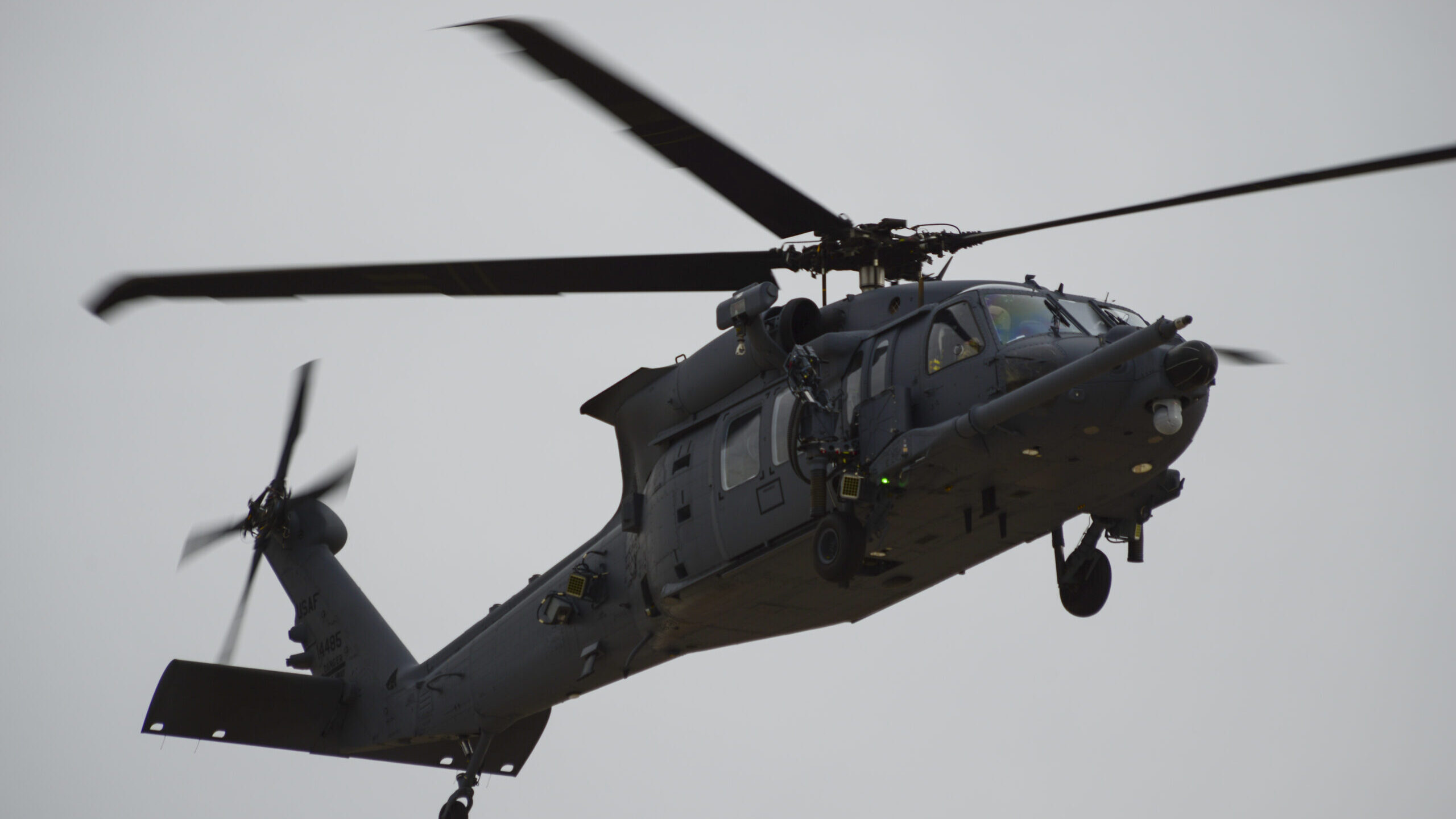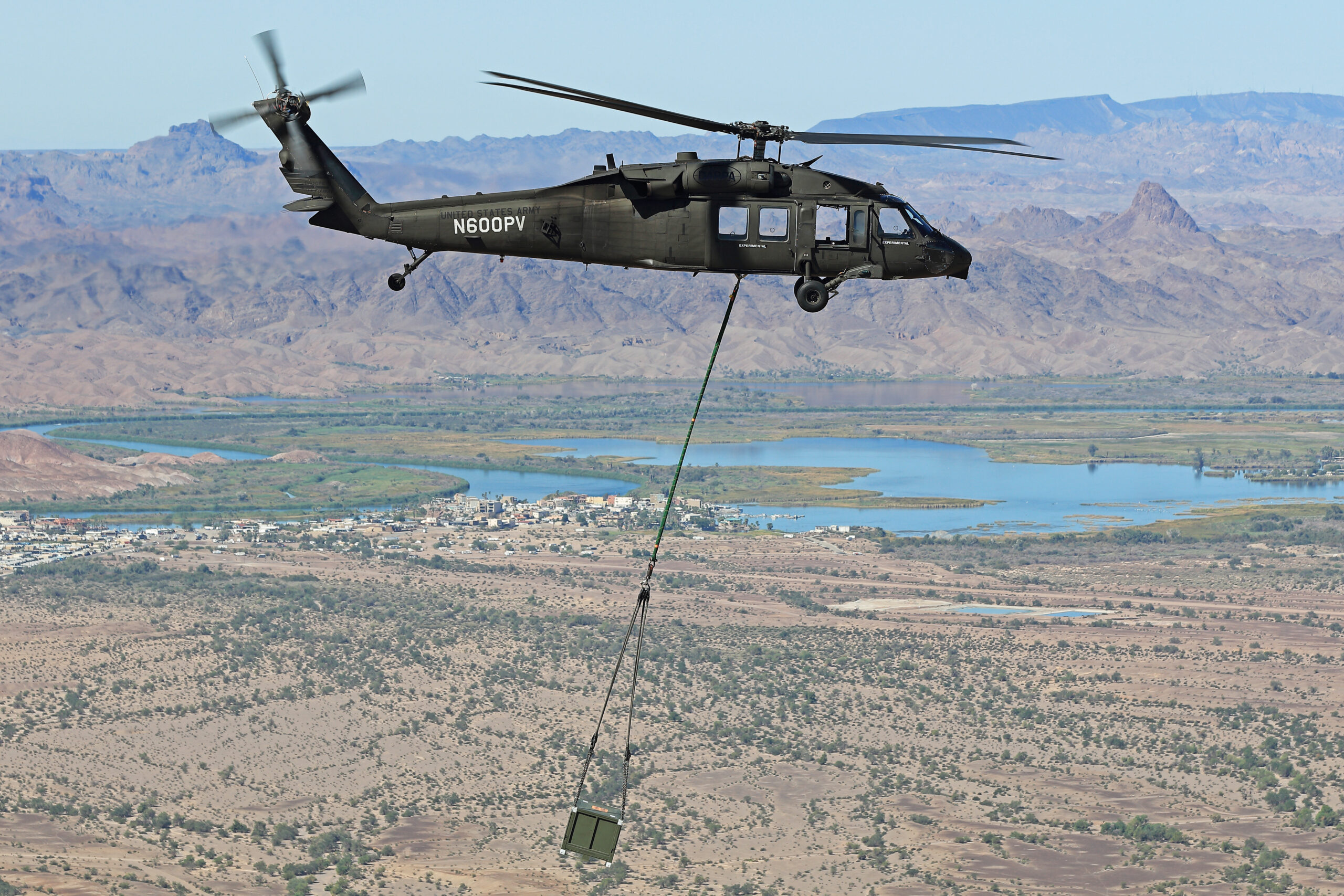
An HH-60W Jolly Green II prepares to land during a simulated rescue mission Feb. 25, 2021, at Moody Air Force Base, Georgia. The 347th Rescue Group performed its first scramble launch with the Jolly Green II to effectively execute Combat Search and Rescue missions. (U.S. Air Force photo by Airman 1st Class Jasmine M. Barnes)
STRATFORD, Conn. — From the time an order is received at Sikorsky’s facilities, it takes about three years for a brand-new HH-60W Jolly Green II to arrive at this point: the fully assembled helicopter has officially been accepted by the Air Force, and will soon fly away to one day embark on rescue missions around the globe.
This particular helicopter is the 31st the service has taken possession of, but just how many more are slated to roll off its production line here is a source of controversy. As part of its fiscal 2024 budget request, the Air Force stuck to plans established last year to end procurement of the helicopter, dropping an original program of record from 113 to 75.
The Air Force’s dropped buy is driven by a shift in America’s strategic focus, service leaders say. When the program was developed, attention was on conflicts in the Middle East, where US airpower reigned supreme. But the Pentagon’s sights are now set on Europe and the Indo-Pacific, where formidable enemy air defenses threaten to make quick work of slow-moving, stealthless rotorcraft like the HH-60W that may also be forced to fly great distances across the high seas.
During a recent tour, Breaking Defense was provided an exclusive look at where the Air Force’s newest Combat Rescue Helicopter comes together, and while Sikorsky executives interviewed at the company’s headquarters were reticent to rebuke their customer out loud, their message was clear: their helicopter is needed for the mission, despite statements from Air Force leaders to the contrary, especially since no other option will exist in the near term.
“We’ve had very honest and frank discussions with the US Air Force about the impact that truncating the program will have,” said Nathalie Previte, Sikorsky’s vice president of Army and Air Force systems. “As long as there is no alternative,” she added, helicopters like the Jolly Green II represent “the best technology to perform the mission. And I truly believe that.
“When I think back about Igor [Sikorsky], his passion of really pushing the envelope on helicopters was really to save lives,” she added. “The fact that [the military is] putting that as not that critical – it’s becoming a passion of mine to make sure that we provide the Air Force crews that deserve to have the latest technology for combat rescue missions to get what they need.”
As Sikorsky strives to keep the helicopter relevant, it has natural allies in various corners – from the Connecticut congressional delegation, to the National Guard, and even among some airmen who feel the service is at risk of abandoning a core, “moral” imperative – to make its case. Though service leaders seem united in the decision, lawmakers have the final say, and already stepped in during the last budget debate to add helicopters back in.
As Congress nears the markup of the FY24 budget, the fate of the Jolly Green II remains an open question – one with significant repercussions for airmen and industry alike.
A Helicopter For A Different Era
A derivative of the Army’s iconic Black Hawk, the HH-60W is recapitalizing the Air Force’s decades-old fleet of HH-60G Pave Hawks overworked by continuous deployment in Iraq and Afghanistan. The new helicopter is the Air Force’s second attempt to replace the Pave Hawk; the first, known as the CSAR-X program originally awarded to Boeing, was terminated after successful protests from Sikorsky and Lockheed Martin. (The latter acquired the former in 2015.)
With fewer Jolly Green IIs coming behind the fleet of Pave Hawks it will be replacing, lawmakers have expressed concern the helicopter’s truncated buy risks opening a gap in combat rescue capabilities. During budget negotiations last year, alongside the funds for 10 more helicopters, Congress additionally forbade the Air Force from using funds to close its production line.
RELATED: Compromise NDAA released with $857.9 billion topline
Those worries featured once again in hearings this year. “I’m very concerned about the Combat Rescue Helicopter,” Sikorsky home state Senator Richard Blumenthal, D-Conn., told top Air Force leaders during a hearing of the Senate Armed Services Committee in April. “Maybe you can tell me what your thinking is about terminating that program, when I think we all believe we have an obligation to leave nobody behind.”
“We believe [the current fleet is] more than sufficient to do combat search and rescue. There’s a big distinction in this portfolio between combat search and rescue and personnel recovery,” Lt. Gen. Richard Moore, Air Force deputy chief of staff for plans and programs, responded to Blumenthal. (Personnel recovery “is not limited to combat operations,” according to Air Force doctrine.)
“There are literally thousands of platforms in the Department of Defense that can do personnel recovery. This fleet is for something very specific. It was purchased for Iraq and Afghanistan, it is not particularly helpful in the Chinese [Area of Responsibility],” Moore added.
“We recognize the moral imperative… to leave nobody behind,” Lt. Gen. Jim Slife, Air Force’s deputy chief of staff for operations, said during the same hearing. Citing the attempted rescue of Bat 21 Bravo – where during the Vietnam War, multiple airmen and aircraft were lost in a desperate attempt to save Lt. Col. Iceal Hambleton who had to punch out behind enemy lines – Slife went on to caution that relying on less survivable platforms to perform search and rescue could create more problems than they can solve.
“We’re actively looking at non-traditional ways in order to fulfill that moral imperative of leaving nobody behind, but until we can come to a definitive answer on that, I think the one thing we can say is that helicopters – and I have 3,000 hours as a helicopter pilot – that fly 115 knots refueled by C-130s with pararescuemen that ride a hoist up and down is probably not the answer in our most stressing scenarios,” Slife said, adding that the current HH-60W program “bridges the gap until we can develop a more suitable solution for a contested environment.”

An HH-60W sits on its assembly line in Stratford, CT. (Photo credit: Sikorsky)
Despite the views of the service’s top brass, some operators have pushed back. As a recent report in Air & Space Forces Magazine notes, improvements like electronic countermeasures could be fielded to increase the HH-60W’s survivability, coupled with weapons like missiles to make it more lethal.
“The Air Force has entered into a circular argument in the sense they have decided the helicopter is not survivable, so have underinvested in its survivability, which thereby ensures their viewpoint of it not being survivable appears true,” Lt. Col. Brandon Losacker, HH-60G weapons officer, told the magazine.
Still, JJ Gertler, a senior analyst with the Teal Group, highlighted how the war in Ukraine is providing ongoing lessons for planners, who have watched how integrated air defense systems have rendered much of the battlespace off limits for aircraft.
“All of the military services are still studying this war and the lessons continue to change,” he said. “They found out what it means to try to operate low, slow aircraft in a modern air defense environment.”
Even as the needs of modern war evolve, Richard Aboulafia, managing director at AeroDynamic Advisory, pointed out there are still mixed opinions about a helicopter’s effectiveness on the battlefield, leaving open the question of whether the time for current rotorcraft has passed.
“People have reached divergent conclusions about the lethality of the airborne environment,” he said. “A lot of people were saying, ‘It’s the end of helicopter operations as we know them.’ Then the Poles said, ‘We’d like to place one of the biggest Apache orders in history.’ Yes, it’s gonna get messy up there. But this is how it has to be.”
The National Guard Weighs In
Active duty squadrons are going to bear the brunt of the truncated buy, according to an Air Force spokesperson, who said the current fleet is sized to meet federal needs.
“The Air Force remains committed to supporting the Joint Force by maintaining the Department of Defense’s only dedicated Combat Search and Rescue force and will look to utilize a combination of Air Force and Joint Force capacity for Personnel Recovery,” Air Force spokesperson Ann Stefanek said in a statement to Breaking Defense. “The capability limitations of the HH-60W against current and future threats cannot be mitigated with additional capacity.”
Stefanek added that “The final disposition of HH-60W aircraft has not been decided. The Department of the Air Force is taking into consideration the 10 additional airframes authorized in the 2023 NDAA and appropriated above the request in the FY23 President’s Budget submission. Headquarters Air Force and Air Combat Command are finalizing the plan for a fleet size of 85 aircraft, in close coordination with the Air National Guard and Air Force Reserves, to be considered for resourcing in the FY25 budget.”
Though the Air Force insists that the active duty, not the National Guard or Reserve, are where the cuts will come from, that hasn’t stopped the National Guard from weighing in as the service sorts out how to allocate the fleet. The Guard is currently distributing a fact sheet [PDF] that lobbies lawmakers to restore another 20 helicopters back into the program of record – and to earmark them solely for the National Guard – for a total fleet size of 105 to fill out squadrons it says are at risk of being cut.
RELATED: Air National Guard director wants boost to F-15EX buy
It’s important to understand that the Guard has an outsized political role in these fights. Each state has its own top officer, known as a TAG, who is in regular conversation with their state’s governor and legislators. Making sure the Guard is happy and not losing out on mission sets or equipment is a core function of members of Congress on the defense committees. And that could help gin up support from the delegations of the three states – Alaska, California, and New York – that the Guard’s fact sheet says are at risk of having squadrons cut.

The HH-60W Jolly Green II arrives at the 58th Special Operations Wing at Kirtland Air Force Base, New Mexico, Dec. 17, 2020. (Staff Sgt. Enrique Barcelo/ Air Force)
It is not immediately clear what the fate of squadrons that will ultimately be impacted by the truncated program may be, though Air Force Secretary Frank Kendall recently explained that the service strives to replace platforms with similar ones, or at least assign related missions for squadrons whose hardware gets cut.
“We’re trying to replace current aircraft we divest with like aircraft where we can – fighters with fighters, for example. If we can’t do that, then we try to replace a flying mission with a flying mission. And where we can’t do that, we put in another mission that’s going to have a lot of longevity and bring similar value to local communities,” he said May 9 during a forum hosted by the Special Competitive Studies Project dedicated to the late former Defense Secretary Ash Carter.
National Guard personnel can be deployed abroad, though they also have domestic responsibilities when activated to respond to events like natural disasters. When asked about the impact the truncated buy could have on domestic missions, a spokesperson for the National Guard told Breaking Defense that “The National Guard will not speculate on possible effects, but as it relates to domestic missions, each Governor is able to request capabilities and personnel through the Emergency Management Assistance Compacts to meet emerging needs.”
Should the National Guard end up short on HH-60Ws, Gertler said training these squadrons on a different platform could still enable them to meet Title 32 needs – the statutory authority that guides the use of Guard personnel for stateside missions like natural disaster response – but leaving them without those helicopters would impact their ability to effectively rotate in on more traditional military deployments known as Title 10 missions.
“It comes down to a question of, Do you want your National Guard to be able to integrate seamlessly into combat activities side-by-side with the active, or do you want your National Guard tailored for the state mission?” he said.
Finding An Alternative
Key to Sikorsky’s argument for the helicopter’s relevance is that there is no clear other option on the table to do the mission, something the Air Force has tacitly agreed with.
The Air Force is “in exploration mode” to find whatever might provide the capabilities that the HH-60W can’t, a service official previously said, identifying potential key attributes like uncrewed and high-speed platforms.
“What you really see is the Air Force taking a technology pause to see what their options are,” Gertler reasoned about the service’s decision to halt procurement of the HH-60W. “The development of Future Vertical Lift by the Army is bringing new choices into the field and the Air Force is consciously waiting to see how those options mature, because they may be a better answer for some of the Air Force missions.”
David “Rum” Morgan, director of Air Force business development for Sikorsky, similarly noted that the service may have other options down the road, but it’ll be many years until they’re available.
“There are options for the Air Force to look at in the future,” Morgan said, pointing to the Army’s FVL, “but the problem is the timing. Those aircraft for the Army are not really going to be operational – and the Army’s looking at the first unit equipped in the 2030 or even later timeframe – and then the Air Force would have to develop a rescue variant, which would take a few years.”
Paul Lemmo, Sikorsky’s president, pointed to one of those future possibilities: a Defense Advanced Research Projects Agency effort to develop a high speed vertical takeoff and landing plane – known as the Speed and Runway Independent Technologies program (SPRINT) according to a report in Defense One – though Lemmo said to the best of his knowledge the Air Force has not sought real input for the project.
“As far as I know they haven’t engaged anyone, at least in industry,” he said, pointing to a lack of a general announcement like a request for information.

A Black Hawk helicopter outfitted with DARPA and Sikorsky’s ALIAS system performs a mission during Project Convergence 22 at Yuma Proving Ground, Ariz. (Photo courtesy of Sikorsky).
Work is progressing to field underlying technologies key to unlocking the next generation of combat rescue. At the Yuma Proving Ground last year during the Army’s Project Convergence, an autonomous Black Hawk was programmed to move cargo and airlift a dummy patient to a hospital, which Lemmo cited as an example.
“In our view, [the HH-60W] fits in the modern battlefield in the ways that you would expect in terms of connectivity and capability. You know, obviously in the Indo-Pacific theater they may be looking at threats that we’re not aware of,” Lemmo said.
“They say this may not be survivable, but I’m not sure,” he continued. “The question would be, you’re replacing a certain number of [HH-60Gs] with a lesser number of [HH-60Ws], actually a significantly less number. Is that really going to cover what you need? I can’t answer that, only they can, but there is a big disparity in terms of just the numbers of aircraft that they’re going to have available.”
With much emphasis on autonomy, officials will have to overcome potential limitations. For example, a wounded service member may not be able to secure themselves in the vehicle alone. And once they’re in there, the vehicle has to make it back.
Floating out at sea, in the event of an Indo-Pacific scenario, a service member may have to hope a friendly vessel is nearby to pick them up; otherwise, an enemy ship – or an enemy shark – could get there first.
“If you think about a combat rescue helicopter, it’s still going to be much more responsive than the ships that might be [used] to rescue someone lost at sea under an INDOPACOM scenario,” Previte argued, using the shorthand for Indo-Pacific Command.
RELATED: Sikorsky-Boeing will not sue Army over FLRAA
Lawmakers will soon weigh in on the future of the Jolly Green II, with key defense committees nearing the markup process, where lawmakers make suggested changes to budgets and policies as the House and Senate prepare for negotiations. However, an impasse over the nation’s debt ceiling has stalled that process, Politico reported.
Asked directly if the company was lobbying Congress on the issue, a Lockheed Martin spokesperson responded only with a general statement about the capabilities of the rotorcraft.
As part of the FY23 National Defense Authorization Act, the Air Force was also required to submit a report on combat search and rescue requirements that includes the impact of truncating the HH-60W buy, though it’s not clear if that document has been sent to Congress.
Regardless of what lawmakers decide, industry, for now, is mostly left with questions about what comes next.
“I think the question will be, what kind of a platform, you know, do they want? Is it stealthy? Is it high speed?” Lemmo asked. “You know, what is it?”






















